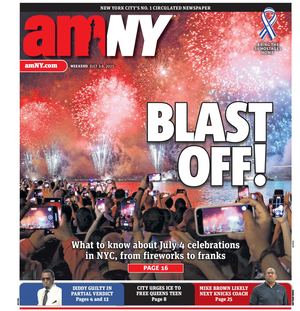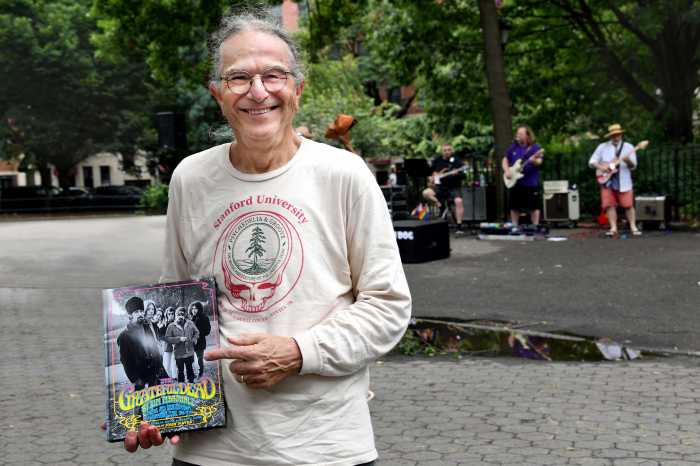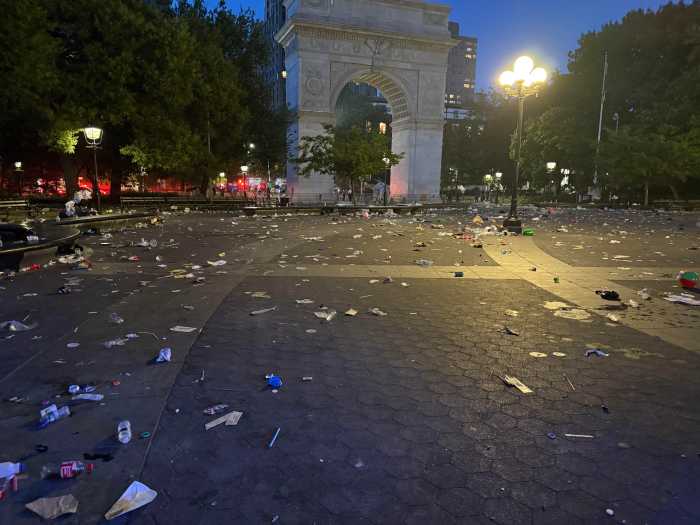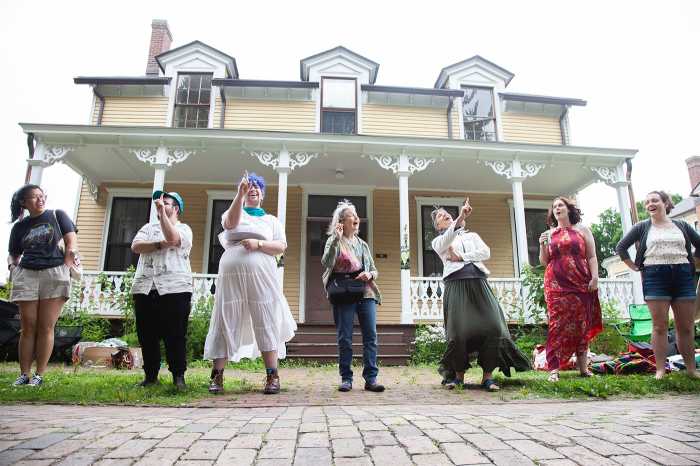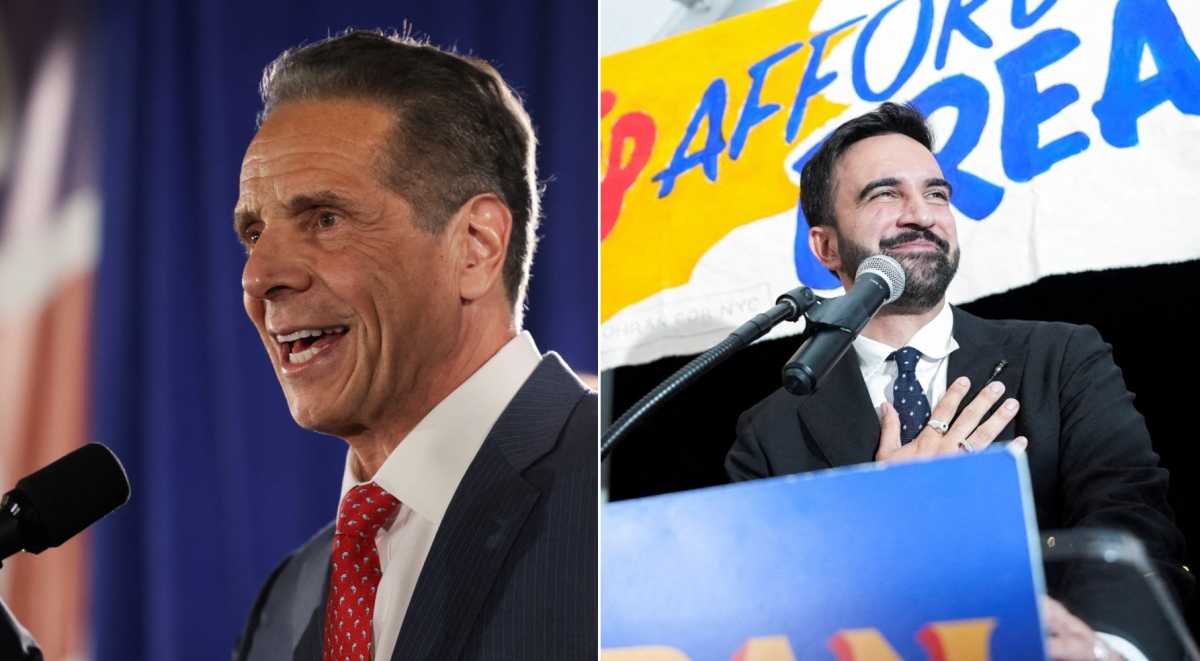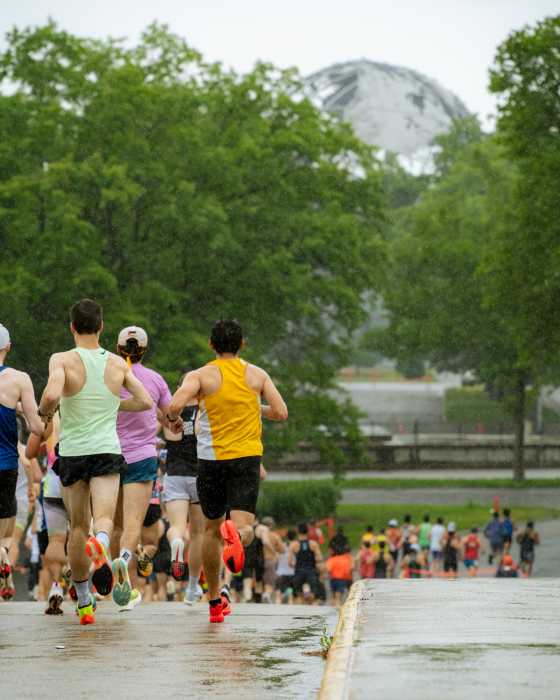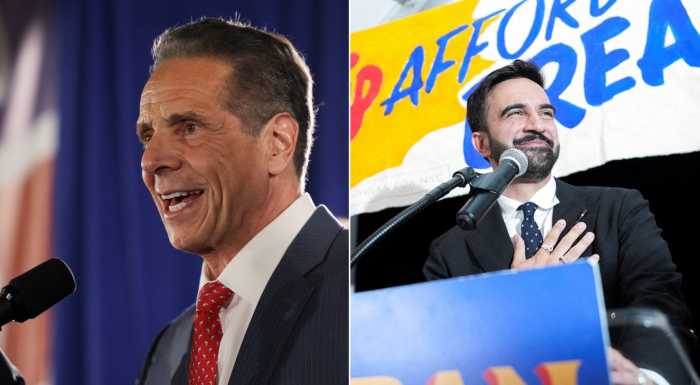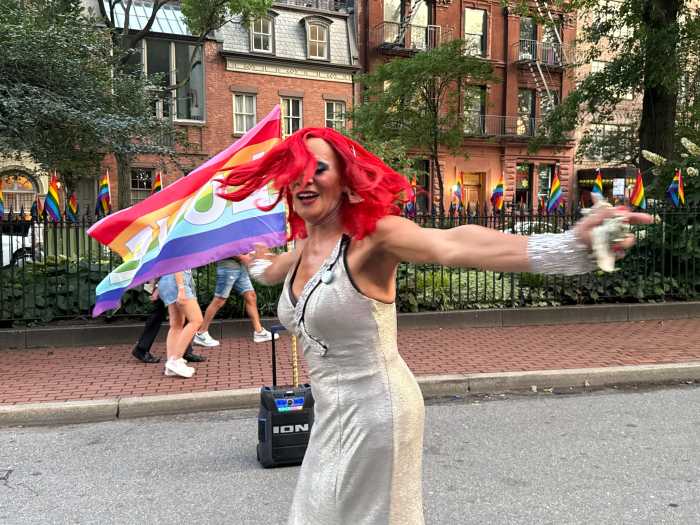By Gabriel Zucker
While most of the Meat Market was lamenting the loss of the iconic diner Florent last week, the owner himself, Florent Morellet, was speaking excitedly about the changes he had worked on and that the city’s Department of Transportation had finally implemented in Gansevoort Plaza.
“One hundred years ago, the streets were all for pedestrians, and gradually the car pushed and pushed and pushed,” Morellet said. Now, he boasted, the Meat Market is an area “where the pedestrian is more the king and the automobile is the visitor.”
After several years of planning, D.O.T. — following the suggestions of Morellet and Jo Hamilton, who were working through the Greater Gansevoort Urban Improvement Project, and Community Board 2 — installed six pedestrian spaces on the street beds of Greenwich and Gansevoort Sts. The spaces are separated from traffic by tree planters, concrete blocks and bollards, and range from a large open area on Gansevoort St. to smaller “neckdown”-type enclosures in front of the restaurants Gaslight and Vento at 14th St.
The temporary installations, which will ultimately be replaced by a permanent capital project, are meant to reduce traffic flow and create new public spaces for the neighborhood.
But the changes have not been received so favorably by all members of the community. Nearly three months after D.O.T. finished installing the traffic dividers three months ago, the tone in the neighborhood is decidedly mixed.
Some, like Morellet, celebrated the reclaimed pedestrian spaces.
“They create social interactions that haven’t happened between community members,” said Ian Dutton, vice chairperson of C.B. 2’s Traffic and Transportation Committee.
“I love the public spaces,” agreed Ivy Brown, one of the neighborhood’s handful of legal residents, who lives at 13th St. and Ninth Ave.
But 122 responses to a local survey by the Meatpacking District Initiative, a group promoting the area and its new businesses, told a different story on the reception of the new public spaces.
“People primarily felt negative,” said Annie Washburn, the group’s executive director. “I would hope that D.O.T. would be responsive to the community’s request for change. There need to be changes.”
Washburn and David Rabin, M.P.D.I.’s president, could not supply specific numbers because they are still analyzing the results. But Rabin said in a statement that “the initial feedback indicates great concern regarding both the aesthetics and the functionality of the new configuration.
“Both residents and the business owners on Ninth Ave. have expressed serious concerns,” he said.
However, Brad Hoylman, Community Board 2’s current chairperson, who was the board’s Traffic and Transportation Committee’s chairperson when the designs were being planned, urged the neighborhood not to take the survey too seriously.
“It’s too early for any assessment. That’s a point of view, but not the only point of view,” he said of the critical reactions to the M.P.D.I. survey. “That’s a snapshot, and I think we need to give this more time.
“Change is always going to be bumpy,” he said. “We shouldn’t go to any snap judgment.”
Still, the aesthetics issue has indeed resonated with many in the area.
“I was speechless,” wrote Amy Ellison, a neighborhood resident, in an e-mail to the Greenwich Village Society for Historical Preservation after first seeing the change to what she said had formerly been “a large, beautiful expanse of cobblestones.”
“The area has been broken up into compartments of concrete installations that destroy the entire look and feel of the area, which I thought had been landmarked,” Ellison wrote. “I frankly find billboards less offensive than what has been done to this historic area.”
Zack Winestine, a West Village resident and activist, who overwhelmingly approved of the installations, also agreed that there was “room for improvement” in the design.
“I don’t think that they really quite turned out the way people were expecting them to,” stated Andrew Berman, G.V.S.H.P.’s executive director, which has yet to issue an official response.
“I don’t think it goes with the aesthetic of the cobblestone,” said Kendall Morrison, an employee at the clothing store Theory on Gansevoort St., as she ate lunch on the new street structures last week.
Morellet stressed that the design was temporary.
“The street furniture is straight off the rack of D.O.T.,” he said. “This is temporary; it looks temporary. Of course, it’s not as pretty as it will be.”
Gallery owner Brown was already brewing up suggestions for the design’s improvement, suggesting that the white stripes at the spaces’ perimeters, which are already being ripped up from use, be replaced with larger stones.
Locals were less in agreement on the changes’ impact on local traffic. Most agreed that the dividers had tamed the vehicular free-for-all that existed before, even cutting down the number of cars and making it much easier for pedestrians to navigate crossing the street.
“There used to be taxicabs jockeying; it was impossible to cross the street, it was so wide,” said Chris, an employee at the local jewelry store Dogmatic and a former neighborhood resident.
But others felt that, in taking too much space away from cars, the changes had increased backups into side streets and congestion in the neighborhood.
“It gets to be a mess here at night,” said a Hotel Gansevoort employee who asked to remain anonymous.
“There has been more honking and more traffic jams,” echoed Alex Hasbany, general manager of Spice Market restaurant at Ninth Ave. and 13th St. “It hasn’t helped traffic congestion; if anything, it’s made it worse.”
Michael Bloomberg, who lives across from Spice Market, agreed that “the horns can go on nonstop for hours.”
“This attempt to control traffic by blocking the street down has just pushed the traffic way down into the Village,” said Bloomberg, who recommended lengthening the northbound traffic light on Ninth Ave. and 14th St. to allow cars to leave the neighborhood.
Brown pointed out that the intersection with Spice Market was the worst, because one of the installations prevents drivers from driving across Ninth Ave. on 13th St., and motorists are not yet used to the change. She also cited pedestrians who hail taxis from the pedestrian spaces in the middle of Ninth Ave., causing cabs to stop in the middle of the street and block traffic.
“The traffic needs to respect the pedestrian, and the pedestrian needs to respect the traffic,” Brown said, noting that drivers were slowly learning to avoid the area, but that taxis would keep coming, given the great “potential clientele.”
To C.B. 2’s Dutton, the congestion is the result of the weaning process that was intended.
“The traffic is showing that people shouldn’t be driving around and around and around in the area around Gansevoort,” he said.
Morellet agreed that it was a matter of changing the driving mentality, telling the story of a customer who complained about the 10-minute taxi ride from Hudson St. to Washington St.
“I said, ‘Did it ever occur to you to get out and walk the last block?’” he asked with a smile. “And the guy looked at me like I was an idiot.
“It’s so hard to change the mentality of the people, but when it changes it changes for good,” said Morellet, who was elated that high gas prices are forcing people to abandon their cars.
Even for those who are happy with the installations, however, problems may arise regarding their maintenance.
“I run an organization that raises $400,000 a year to market the neighborhood and do events. By default, we’re in charge of taking care of the space,” said Washburn, noting that “thousands and thousands” of people go by the new structures every night. “I don’t really have a budget to do that,” she said.
Hasbany also reported the hassle of having a cleaning crew maintain the new public space in front of his restaurant, which is treated like an extension of the sidewalk, although two other restaurants similarly located in front of the new spaces said it had not been an issue.
“I’m all for public spaces, but this should have been planned out a little more thoughtfully, a little more creatively,” Hasbany said.
Like them or not, however, the spaces are certainly getting their share of public use — during the day and at night.
“During prime time at lunch, it’s hard to find a spot,” said Chris, who was eating a sandwich on one of the concrete structures last week.
To some residents, the multitudes of nighttime users can get excessive.
“They’re creating a place for drunk people to sing and yell,” complained Bloomberg.
Morellet, to some extent, welcomed the revelers.
“Cities need small districts with no residents, where young people can have fun, get drunk. We did it,” said the 55-year-old. “Drunk people were hooting and hollering before. It doesn’t make any difference — except before they were in risk of getting hurt.”
For now, although M.P.D.I. is sending its survey results to D.O.T. for review, most organizations in the area are waiting to “let the designs settle,” as Dutton put it. M.P.D.I. is considering planning events in the biggest of the spaces — the Gansevoort enclosure. Last Wednesday, a concert production of Hair was presented by the Public Theater and the Theory Icon project there; M.P.D.I. has also spoken to Greenmarket about bringing a farmers market there, which Greenmarket says is still in the exploratory phase.
Although there are no long-term plans in the works as of yet, Dutton expressed interest in another of G.G.U.I.P.’s proposals, which was to raise the street bed of the Gansevoort Plaza to make it level with the adjacent sidewalks to create what they called an “Italian piazza,” although Dutton admitted that it would be a “major capital undertaking.” Morellet said such discussions might begin in about a year.
Even as the neighborhood uneasily absorbs the changes, Hoylman urged locals to look at the positive aspects.
“We’ve taken a street bed and turned it into a public space, which doesn’t happen very often in New York City,” he said. He also emphasized that the plan was “innovative” in that “it was a grassroots planning effort,” and “not the usual top-down approach of city government.”
Morellet also hoped that the neighborhood would not reject change, especially out of a misplaced nostalgia for the 1980s.
“My staff in the middle of the night used to go home in groups of three at least because we would be mugged,” he said of his restaurant’s early days, before the neighborhood’s development.
The French native also dismissed those who would resist change entirely.
“We left a place where change was nonexistent,” Morellet said of immigrants like himself. “We came to New York because it’s a place of change.”
